Duct air conditioner with forced ventilation: subtleties of selection and installation
A modern ducted air conditioner with forced ventilation provides not only a comfortable room temperature, but also ventilation. In addition, additional modules of the air preparation system allow you to remove dust and regulate air humidity.
An ionizer and an ultraviolet biologically active filter are easily integrated into the system. Agree, it is very tempting to immediately normalize the microclimate in the room. Let's take a closer look at the ducted air conditioning system.
The content of the article:
Features of duct air conditioners
Traditionally, cooled air is supplied through ducts in industrial premises, large stores, offices, and on ships. However, air conditioners with forced ventilation for a house or apartment are installed less frequently.
This is due to the fact that the common wall-mounted split option is easier to install. But, if you want to ensure the best climate conditions in your rooms, a split system will not be enough.
For example, for a room of 25 square meters. m. 60 cubic meters required. m of fresh air per hour. Even expensive wall-mounted split systems with forced ventilation have this parameter half as low. It is impossible to build additional effective filters and humidifiers into wall modules. That is why the optimal climate is provided only duct systems.
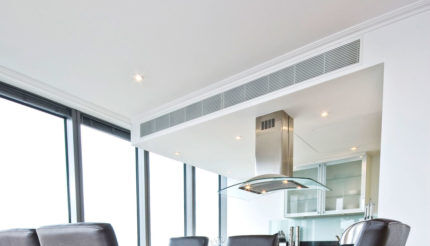
The duct air conditioner consists of two blocks. A unit with a compressor is installed outside. An evaporator with a heat exchange circuit is installed in the ceiling space or utility room.
Install a ducted air conditioner between the suspended ceiling and the ceiling, in the dressing room or in the utility room. The power unit is installed where sounds from equipment operation will not create problems. Thanks to this, in living rooms there is significantly less noise when operating a ducted system, compared to any other type of air conditioner.
The cooled air flow is distributed between rooms through thermally insulated air ducts hidden in the ceiling space. In addition to cooling, the duct system is capable of supplying fresh air in the required volumes.
Agree, this approach is optimal. There is no need to put mesh on the windows, the amount of dust in the room is reduced, and it is easier to regulate the relative humidity of the air.
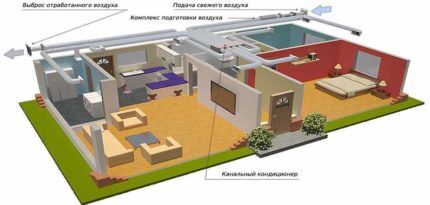
As you can see, using one duct-type air conditioner is quite enough to cool all rooms in an apartment, house, office or store.
It is only necessary to correctly calculate the proportions of air exchange, select the cooler power unit of the required power, and plan the installation of additional air preparation units.
Air conditioning system parameters
The first thing you need to pay attention to is heating output. Using this parameter, the device is selected based on the volume of all cooled rooms.
Second point - air pressure. Long ducts with bends resist air flow. The longer the channels, the more air pressure needs to be created. There are low-pressure (up to 50 Pa), medium-pressure (up to 100 Pa) and high-pressure (from 100 to 250 Pa) systems.
Blocks with a pressure of 100 Pa are suitable for an apartment. Some models have a pressure mode switch. This is convenient because you can adjust the pressure depending on the existing air duct without much consideration of the channel parameters.
Next point - fresh air supply. Not all ducted air conditioners provide room ventilation. The supply ventilation unit is equipped with heaters. They prepare air from the street during the cold season.
It is also necessary to heat cold air in order to prevent condensation from forming on the walls of the air ducts.
Heater power – another parameter that is important to consider when choosing equipment. In the southern regions, a unit with supply ventilation with a power of 5 kW is suitable for a four-room apartment.
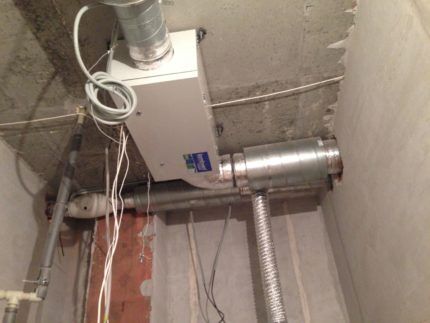
If you plan to install an additional filter in the duct, you should choose an air conditioner with an air pressure 15-30% higher than the recommended parameter.
Determining the required equipment parameters
At the very beginning it is determined air conditioning power. In practice, this parameter is taken from the air conditioner passport of any system. Then a proportion is drawn up taking into account other volumes of premises.
For example, a wall-mounted split system with a cooling capacity of 3.5 kW provides cooling of a room up to 40 square meters. m. For an apartment of 120 sq. m. m. you will need a unit with a productivity three times greater, 28-30 kW.
Quick calculation has disadvantages. Factors such as sun illumination of windows, methods of shading rooms, and the amount of thermal insulation of walls and ceilings are not taken into account. The error can be leveled out by a small margin for the parameter under consideration.
The required air pressure is more difficult to calculate. To do this, make a sketch air ducts. The branching and total length of the channels are determined. Take into account the resistance of additional filters and air ionization systems.
In addition, you also need to take into account the volume of fresh air. Usually 20-30% of air from the street is mixed.

All data is transferred to an engineer who is well aware of the characteristics of duct air conditioners of a particular model. After looking at the sketch of the channels, the specialist will select a system with sufficient air pressure.
As a rule, for four rooms with a total area of 140-200 sq. m. models with an air pressure of 100 Pa are suitable.
Which duct is better?
Air channels rarely run exactly as indicated in the documentation or sketches. Sometimes you need to go around the beam, often the distances are indicated with an error. Such errors are not of great importance if a corrugated pipe is used. It is cheaper than air ducts with smooth walls and is easier to install.
But there are also disadvantages. Flexible channels sag between suspension points. At the attachment point, the clamp compresses the pipe, reducing the cross-section of the channel.All this and the corrugated surface of the corrugated walls provide significant resistance to air flow. A situation may arise when the airflow to the radiator of the indoor unit is insufficient.
In this case, the automation will work and turn off the compressor. Thus, it is better to use ducts made of pipes with smooth walls. Not only do they have less resistance to air flow, but they are also less likely to become dirty. And they are much easier to clean.
In addition, the thermal insulation of ducts is an important factor that influences not only the efficiency of the air conditioning system, but also reduces noise in the rooms. A galvanized steel duct is much easier to insulate than a flexible corrugated pipe.
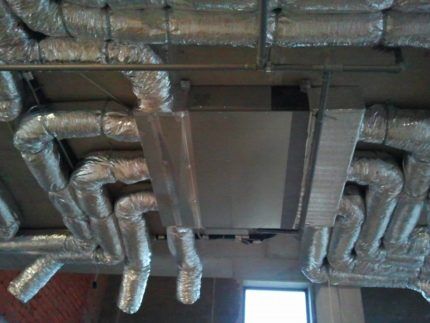
Separately, we note that polymer is not suitable for supply ventilation. Pipes made of polymer materials have a coefficient of thermal expansion 10 times greater than that of steel. For this reason, the polymer is difficult to coordinate with steel load-bearing structures. And the smell of plastic cannot be eliminated.
Installation of air conditioning system
The easiest way install air ducts and blocks - entrust the installation of equipment to a specialized organization that guarantees the quality of work in the contract.
But even so, you will need to check a number of points:
- the design should include easily removable panels for quick access to filters and air treatment system units;
- the fastening of a duct air conditioner, a supply ventilation unit, or air ducts should not lead to vibration of the suspended ceiling.Load-bearing elements must be made separately, without using the profile of the suspended structure. Then the system will work silently;
- Electrically operated valves must be accessible after finishing work.
During installation of the drainage system of a ducted air conditioner, the elements should be checked and compared with what is specified in the manufacturer’s instructions. Otherwise, after turning off the system, water may get inside the room - this is important for high-pressure systems.
What to consider during installation?
To create the channels, you will need a special large-diameter diamond drill. It will not be possible to make holes in panels with a diameter of more than 200 mm using a conventional hammer drill.
You can mark the notches yourself. Then invite specialists with a diamond drill (if such equipment is not available on the farm), they will make holes quickly, without disturbing the neighbors with noise.
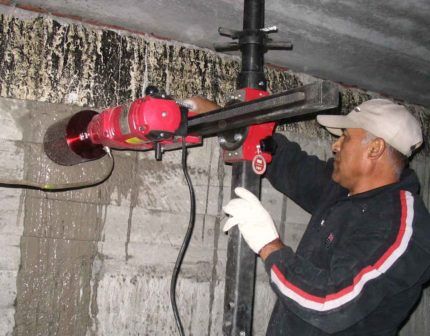
If you have enough experience, you can purchase ready-made air ducts and combine them into a single system, or you can order the production of air ducts according to sketches in a workshop that works with tin.
Boxes or round air ducts made of galvanized steel are made on machines by rolling the joints. It would be a good idea to check each item when receiving the kit.
Taking into account all the recommendations in the article, an experienced master can carry out the rest of the work independently.
It is useful to follow the instructions:
- The indoor air conditioner unit should be placed in service rooms or in the attic if the air temperature there does not drop below 10 °C. Otherwise, the block must be insulated.
- Throttle valves are installed at the branching points of the channels. The total cross-sectional area of the holes in the throttles should be 20-30% larger than the cross-sectional area of the supply air duct.
- To reduce noise in systems with a pressure of more than 150 Pa, a muffler is installed at the outlet of the indoor unit - a short section of air duct with a larger cross-section than the main line.
- The outdoor unit is mounted either on the roof of the building or on the wall. After installation work, specialists are invited. They will check the connections for leaks and fill the system with refrigerant.
- When planning installation work, take into account the terms of the warranty. Installation of a ducted air conditioner is often required only by official representatives of the manufacturer.
The operation of the air conditioner is negatively affected by power surges. A voltage stabilizer or at least a cut-off switch should be provided.
Conclusions and useful video on the topic
The video shows ducted air conditioning systems and talks about the operation of ventilation:
A ducted air conditioner with a forced-air ventilation system provides better indoor climate conditions than conventional split systems.
If you study the manufacturer's instructions and follow the advice of professionals, you can avoid mistakes when installing a duct air conditioner. Some of the complex work should be entrusted to specialists, and the rest should be done independently. At the same time, the cost of installing equipment will be comparable to installing wall-mounted split systems in each room separately.
Do you have experience installing air conditioning and ventilation in an apartment or house? What difficulties did you encounter? Please share your information in the comments to our article.



